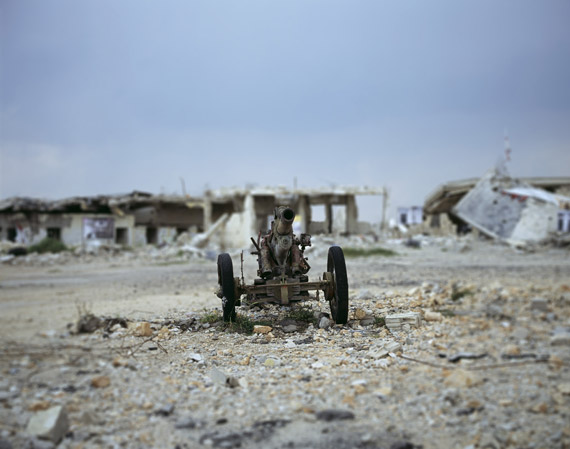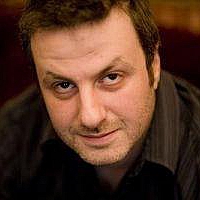
Joana Hadjithomas and Khalil Joreige
Centre de la photographie - Genève 28 rue des Bains 1205 Geneve Suisse
After their two collaborations with the International Festival of Cinema VISIONS DU RÉEL, the Centre de la photographie Geneve (CPG) took the initiative to organize a presentation of Joana Hadjithomas and Khalil Joreige works at CPG, as their works have video-cinematographic qualities as rich as they excel in the photographic realm.
The CPG will not only show photographs by these two artists, born in Beirut in 1969, but also show two videos that cannot be shown other than as an installation.
The title of the exhibition is the name of a multiface project. The first part of it is a serie of burnt photographs of old postcards representing Beirut attributed by the artists to a fictive photographer. WONDER BEIRUT could equally correspond to an important part of the artistic work of Joana Hadjithomas and Khalil Joreige. As at ease in the domain of the documentary as within the domain of fiction, the two artists, who now live between Beirut and Paris, pose, with each new work, the question of how to represent memory, and at the same time, how to represent the war.
In addition to showing WONDER BEIRUT, the CPG will show CIRCLE OF CONFUSION, WAR TROPHIES, as well as the two video-installations DISTRACTED BULLETS and KHIAM 2000-2007.
The sub-title of the first part of the project WONDER BEIRUT, "The story of a pyromaniac photographer", says a lot about the nature of the project. It is about the photographer Abdallah Farah who was commissioned by the Lebanese Tourist Office, to make a series of 24 postcards of Beirut (some of which are, moreover, still on sale today) as well as 12 images for the official calendar of 1969. The idea was to represent the modern aspects of the city and its Riviera, its luxurious hotels. These same postcards are still on sale today in bookshops even if the places represented were almost totaly destroyed during the civl wars. When the civil war started, Farah burnt his negatives progressively as the destruction of the city went along between 1975 and 1990. He tries to update them to reflect the present, the events that are happening and to the bombardments that deface or destroy the photographed buildings. These are the "Historical Processes". The "Plastic Processes" is another category within the WONDER BEIRUT series. This time, the photographer decides on the destruction of the negatives from criteria he establishes himself. He invents destructions, provoked new ones.
The third and last category of the project, the "Latent Images", is the representation of rolls of negatives taken by Abdallah Farah but never developed. During the years of war, Abdallah Farah often did not have the products necessary to develop his photographs - the fixing fluids and, most particularly, the paper. He finished by never developing his films, content to have his images "in the box". Today, he does not feel any necessity to develop them. On the contrary, each of his undeveloped rolls of film is dated, archived and conserved in a drawer. Each photograph is described in precise and minute detail. Presented as contact sheets, they create a journal that relates family life and sentiments, photographic research and a moving history of contemporary Lebanon.
CIRCLE OF CONFUSION depicts a large aerial view of Beirut in 1997, seven years after the war was officially finished. The photograph measures three meters by four meters. It is cut into 3000 pieces which are stuck to a mirror. Inscribed on the back of each of the pieces is "Beirut does not exist" as well as the number of the piece. The public is invited to take a piece of their choosing. The image of Beirut obviously becomes fragmented and each time a spectator extracts a piece he discovers more of the mirror, which confronts him with his own image. The more the mirror is uncovered, the more it reflects the context within which it is exhibited. The Circle of Confusion is the epilogue of a project entitled "The archaeology of our view". The artists question themselves about how to represent a city? How to rediscover the materiality and the power of the image? Despite the invitation to the public to take these fragments of Beirut, the photograph can never disappear completely as it is three meters high. As they go along and take fragments with them, the public is destroying the entire image, but by the same gesture, constructs their own image of the city and discovers their reflection in the mirror. In other words, the reflection becomes part of the image, which only becomes animate with the presence of the spectator. Joana Hadjithomas and Khalil Joreige have written thus about the piece: "We could have just as well written on the back of the fragments, instead of "Beirut does not exist" : "Beirut makes us exist".
The video DISTRACTED BULLET is an installation composed of 5 panoramic views of Beirut taken at moments of celebrations animated by fireworks and the offloading of firearms. In 1994, the militias were disarmed and had to give back their heavy and light artillery; each member of a militia was allowed to keep one firearm in exchange for those that he gave back. On certain occasions, such as marriages, graduations, elections, re-elections or religious holidays, certain of them take out their arms and proceed to fire them with joy to celebrate the event. They then put their arms back in place until the next event. The mixed noise of the fireworks and the gunfire, the intense sound, their orientation, makes it possible to discern the topography of the city and its divisions: the parties celebrating joyously, on one side, and those that remain silent on the same occasion. The sound coming from the installation also determines the position of the spectators, that of the person filming and of the nature and context of the political event. Presented are 15 minutes of 5 events filmed from the same position, the village of Beit Mery, in Metn. As the artists write, one question remains: How many people, who had the good luck to survive the war, have become victims of "distracted bullets" (the exact translation of the world in Arabic "Rassassa Tayiche") fired at these different festivities? Impossible to determine, there is no official traces of these victims. Why don't these parallel events appear in the archives of History ? How and why does an event become a document ? How to keep track of these stories held secret ?
The video KHIAM poses questions as to the limits of representation by evoking the life of, or more aptly, the survival of, prisoners in detention camps - using as its example that of Khiam in southern Lebanon. Conscious of the fact that these experiences can only be shared with difficulty, the two artists experiment with a form of narration which, with words, gradually constructs images by evocation. The recital of the ex-detainees compensates for the lack of images of the camp. During the whole time of the occupation of southern Lebanon, from 1978 to 2000, a militia close to the Israeli army, the South Lebanon Army (SLA), controlled all the area, including the camp of Khiam. During this whole period, images of the camp of Khiam were unavailable. One only heard the camp spoken about. A feeling of urgency comes through this film, which was shot a few months before the liberation of the south of Lebanon and the dismantling of the camp. Six witnesses - three women and three men - speak to Joana Hadjithomas and Khalil Joreige's camera about how they lived, slept, dreamed and what they though of during their six to ten years of incarceration between the four walls of a cell that measured one meter eighty by eighty centimetres, without even the most basic commodities. They recount how they managed to survive thanks to their artistic work. They clandestinely managed to make a needle, a pencil, a game of checkers... The video KHIAM 2000-2007 is less a political condemnation than a reflexion on the metaphysics of the power of the will to live which enlivens human beings under the most extreme conditions of privation of liberty - under the rule of jailors whose oppressive disciplinary comportment tends to eradicate all traces of humanity. In May 2000, after the retreat of the Israeli troops, the camp was dismantled and transformed into a museum before being totally destroyed during the war of July 2006.
8 years after the first film, Joana Hadjithomas and Khalil Joreige found these six past detainees again to evoke, with them, this destruction, the way in which one must preserve memories, the traces of these places, this History.
WAR TROPHIES is a series of photographs about military vehicles abandoned during the liberation of the South in 2000. These "trophies" were part of a temporary exhibition at the camp-museum of Khiam when they were re-destroyed during the July 2006 war. Photographed from the front in a kind of set up, they seem anachronic and pathetic : they are the indication of another war, the witnesses of a new one. Thus they appear moving, strange and question the spectator's position, his relationship with the images.


